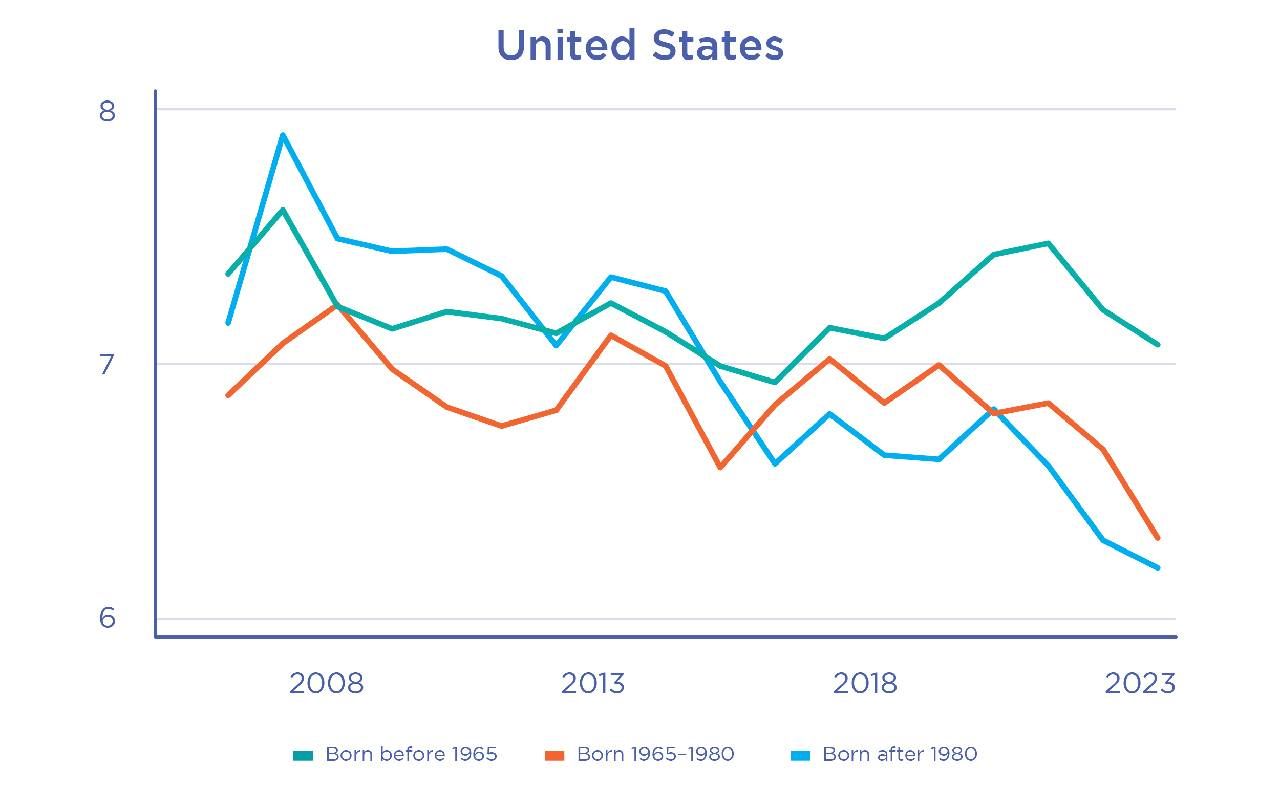Tackling the Happiness Problem Plaguing Young Americans
There’s something happening here — and something older Americans can do about it
"There's something happening here," the opening line in "For What It's Worth," the iconic Buffalo Springfield song, captured the frustrations of a new American generation during the 1960s, a time of social and political upheaval and unrest.

The same line might well reflect the unease of young Americans today. Too many of them are unhappy, and that should be an urgent concern, not just for academics, policymakers and business leaders, but for older Americans who can make a meaningful difference in the lives of their younger counterparts.
U.S. performance in the recently released 2024 World Happiness Report was disappointing, raising serious questions about the quality of American life. Among the 143 countries surveyed, the U.S. ranking fell to 23rd, dropping out of the top 20 for the first time since the report's inaugural publication in 2012. The dip reflects a worrisome trend — the years since 2010 have not been good ones for America's standing.
Indicator of Future Health and Well-Being
The news about young Americans was particularly stark — happiness among those under 30 declined steeply. They ranked 62nd, just behind their peers in the Dominican Republic and barely ahead of countries such as Malaysia, Russia and Kazakhstan.
Despite record levels of economic growth and wealth creation, the U.S. is falling in measures of well-being.
Focusing on self-reported measures of well-being, the report employs six variables — social support, generosity, freedom to make life choices, freedom from corruption, healthy life expectancy and GDP — to help explain different levels of happiness.
More than a snapshot of the present, happiness is also predictive of future health and well-being. Studies suggest that happier individuals live longer, experience fewer chronic diseases, and have lower levels of stress. They are also more likely to eat and sleep well and exercise.
It's not just that happier people live more years. They are more likely to experience better years — longer healthspans, or years of good health that enable them to remain engaged and productive members of society. That opportunity is crucial to all ages and generations, but especially for young Americans today who have the potential to live longer and healthier than any other cohort in human history.
With healthy, happy lives, they can fuel creativity, innovation, productivity and widespread national prosperity. They can take on the great challenges of our time.

But something is not working. Despite record levels of economic growth and wealth creation, the U.S. is falling in measures of well-being — and that risks not only the future for young Americans, but the future for us all.
Economic Inequality Feeds Disillusionment
It should come as little surprise.
Americans of all ages struggle to access basic needs, including health care, education and affordable housing. Economic inequality, financial insecurity, social fragmentation and cultural polarization are obvious problems.
Disillusionment is fueled by social, political and environmental divides — and for younger generations, by the burdens of student debt and job insecurity. The internet and social media exacerbate feelings of inadequacy, alienation and disconnection.
Loneliness made headlines last year following the alarming Advisory from U.S. Surgeon General Vivek Murthy. In Our Epidemic of Loneliness and Isolation, Murthy writes, "social connection — the structure, function and quality of our relationships with others — is a critical and underappreciated contributor to individual and population health, community safety, resilience and prosperity." He says that a lack of social connection is associated with increased risk of heart disease, stroke, dementia, anxiety and depression.
Young People Affected Most of All
In today's America, young people are disproportionately afflicted by social isolation and loneliness. That is especially worrisome for both Murthy and the 2024 World Happiness Report authors. The report notes that loneliness is almost twice as high among American Millennials as those born before 1965.

This loneliness epidemic hits Americans ages 15 to 24 especially hard. Many experts conclude that social media is a key culprit. Social psychologist and New York University Stern School Professor Jonathan Haidt's research and new book, "The Anxious Generation: How the Great Rewiring of Childhood is Causing an Epidemic of Mental Illness," documents the correlation between the surge in social media and plummeting youth mental health.
Young Americans also struggle in the workplace. In a recent Gallup poll canvasing employee engagement and well-being, Millennials and Gen Z cohorts have experienced the greatest decline in feeling cared about at work, having opportunities to learn and grow, and finding connection to the mission of the organization, suggesting that younger workers increasingly feel detached from their employers.
Too many young Americans are lonely, disengaged and unhappy.
The bottom line — too many young Americans are lonely, disengaged and unhappy. But something else is happening here, something that offers hope.
Older Americans are much happier than those under 30. In the World Happiness Report, the U.S ranked in the top 10 for people aged 60 and over. The 60-plus cohort also reported feeling less lonely and more socially connected than younger peers, and older Americans were more likely to answer "yes" when asked if they have a friend they can call on in a time of need.
A solution to the challenges of young Americans may be hiding in plain sight. Leveraging their strengths, older adults can stand up and show up for their younger counterparts, actively seeking cross-generational connections, collaborations and alliances, building community, promoting resilience and employing their wisdom and experience to offer support and perspective.
The case is compelling.
Intergenerational Links Benefit Everyone
Extensive research confirms that intergenerational connections benefit everyone. In schools, K-12 students mentored by older adults reap social and emotional rewards and improved mental and physical health; civic engagement among college-age students increases when they are partnered with older volunteers. Mentorship at work builds stronger connections and fosters more collaborative, caring and productive work environments.
The benefits flow both ways. Leading organizations, including CoGenerate and Generations United, amplify research revealing that intergenerational engagement contributes not only to the welfare of younger people, but to better health, a stronger sense of purpose and community and greater life satisfaction in older volunteers and mentors as well. Intentional intergenerational strategies have the power to solve multiple societal challenges, according to reporting from the Milken Institute Center for the Future of Aging.
Tackling the happiness problem plaguing young Americans is going to take work, and the stakes are high. Prioritizing intergenerational relationships and strengthening bonds feels like a good place to start.
Some Solutions to Consider
Community organizations can increase their sponsorship of clubs, support networks, and start or expand sports, arts, music and recreation programs that encourage intergenerational participation.
Programs like AARP Foundation Experience Corps and platforms like Eldera provide opportunities to connect generations.
Businesses can team older and younger employees and invest in cross-generational wellness, training and skilling programs that elevate social integration and incorporate apprenticeship and mentorship.
There's something happening here and there's something we can do about it.
Health providers and payers can elevate preventive screenings, parental education and awareness programs, and counseling interventions that employ older workers and volunteers.
Universities can integrate younger and older learners and incorporate stress management, coping skills and social connection in their offerings.
Media campaigns can raise awareness, advance understanding and promote innovative solutions.
Elected officials and policymakers can step forward to ensure that laws, regulations and policies have teeth and respond to the challenges.
There's something happening here and there's something we can do about it.
Every American deserves to live a happy and healthy life, and that includes today's young Americans and the generations that will follow. We simply cannot ignore America's happiness problem. Older adults and the institutions they so often lead can make a meaningful difference.
Let the World Happiness Report mark a beginning, pushing us to pivot and work toward solutions, together and across generations.


